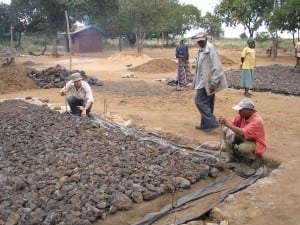Part one in a two-part series
From the engineer’s point of view, development work tends to start when someone identifies a need. Engineers like me and many of those at E4C get involved because the need is great, as is the challenge—finding sustainable solutions for alleviating poverty.
So, when we talk about sustainability, we’re often referring to an individual project. We think about that term as the set of answers to questions like, ‘is the design appropriate,’ ‘was the community involved,’ ‘was it constructed properly,’ ‘will operation and maintenance be performed?’ and so on. This perspective stems from the idea of a project, especially an infrastructure project, as linear operation. We think of it as a time-bound process with a distinct beginning and end.
It is time for us outsiders to find a way to view sustainability from the point of view of the community.
From the point of view of the community or the beneficiaries, however, a project is only one in a series of many that are all part of an ad-hoc development effort going back, in most cases, over 50 years. A host of different people have probably participated in that time, too, including the governments, international agencies, missionaries, community members, NGOs, and so on.
Existing Approaches
Now, the development industry has cast aside the linear view of the project. It views projects as part of a cycle, in which the project ends with an evaluation that informs new plans for the next round of project identification. This creates a knowledge base of successes, failures, and new approaches. It’s often an effective way to improve the performance of the agencies working in the communities. The trouble is, nobody has bothered to inform the communities themselves. So, from their perspective, there is no link between projects; they remain a series of unrelated, discrete efforts.
Proponents of grassroots development say that the key to ensuring long-term sustainability is to encourage the beneficiaries of projects to participate. The benefit, they say, is that it creates a feeling of ownership through contributions to project selection or labor in construction. In practice, there are different degrees of participation. They can range from passive consultation to mobilization, and that usually varies throughout the project process. The trouble then is that outsiders usually dictate the level of participation, and there is no participation at all in the first and last steps of the project cycle. That is, the community only participates in the linear portion of the project, which reinforces the view of projects as a series of unrelated, discrete efforts.

Professionals and volunteers pitched in to build the school in Kenya where Matt Sisul worked as an adviser. Photo courtesy of Matt Sisul
Changing the Approach
It is time then, for us outsiders to find a way to view sustainability from the point of view of the community. We should see each project as part of the ongoing service of delivering infrastructure, and incorporate the knowledge generated through the project cycle into that process. This knowledge base should be managed by institutions within the communities or at a local level, not by outsiders.
To accomplish this, we first need to change how we think about development projects. Then we have to change our approach, designing projects so that they fit this model of infrastructure service delivery from a local point of view. This will require a lot of extra work on our part – us external technical assistance types – but it may be a more responsible approach to development work.
We can start by changing how we think about development projects. First, let’s consider that solutions for poverty alleviation are not purely technical; rather, they’re about people. And infrastructure is people using technology.
Second, we should reduce our optimism bias. That’s the belief that our project will succeed despite a history of mixed results. We do that by acknowledging that the projects that came before ours, even failed ones, were probably executed by skilled people who were doing the best they could with what they had, regardless of how it appears today. And likely, others after us will view some of our projects with derision and consider our conceptions of sustainability inchoate.
With that new measure of humility, we can view each new project as one in a long line and ensure that the process of delivering them will inform future projects. That way, the project becomes a vehicle for development – the act of delivering a project, and not just the finished product, has an impact.
Rethinking participation
From a local point of view, the goal of service delivery is to link projects together, through participation in all steps of the project cycle, and ensure the community manages its own level of involvement throughout the process.
To achieve these goals, we have to rethink how people participate and who represents the community. A local institution must become that representative and incur the responsibility of passing on the knowledge obtained during the project. That institution then becomes an equal partner with the others involved, one that represents the community, manages participation and negotiates the roles that it and the community will take.
In part two of this essay, I will elaborate on this approach to sustainability in terms of design and practice.

